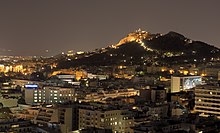Lycabettus
The Lycabettus ( modern Greek Λυκαβηττός Lykavittós , pronunciation [ likaviˈtɔs ], ancient Greek Lykabēttós , Latin Lycabettus , German "Wolfsberg") is the city mountain of Athens .
According to myth, Athena brought this mountain to Athens “to build a protective wall in front of the Acropolis” and dropped it there.
With its height of 277 m, it is the highest point in the city center and offers a good view of the sights of Athens. If visibility is good, you can overlook the entire greater Athens area and its basin between mountain ranges and the Saronic Gulf in the south from here.
There are two ways to climb the summit: On the one hand, take the funicular , the station of which is in Odós Aristíppou, which you come across when following the rising Odós Ploutárchou. Much more rewarding, albeit more strenuous, is the footpath to the summit over the steps through the forest that was reforested between 1908 and 1918 by the “Verein der Waldfreunde”. The climb offers vantage points of the Acropolis , the ancient stadium rebuilt for the 1896 Olympic Games , and the port of Piraeus .
At the summit there is a viewing terrace around the small St. George's Chapel (Ágios Geórgios) with a view of the entire city of Athens, as well as an upscale restaurant. The Lycabettus is not overcrowded by tourists to the same extent as other sights in Athens, despite its panoramic views.
Further below the mountain peak, at the northern end, is the open-air theater designed by Takis Zenetos in 1965 , which can also be reached by car. Concerts and theater performances take place there every summer. It holds about 4000 spectators.
Web links
Individual evidence
- ^ Hans Rupprecht Goette : Athens - Attica - Megaris. Guide to the art treasures and cultural monuments in central Greece . Böhlau, Cologne 1993, ISBN 3-412-03393-6 , pp. 122 .
- ^ Hans Rupprecht Goette, Jürgen Hammerstaedt : The ancient Athens. A literary city guide . Beck, Munich 2004, ISBN 3-406-51665-3 , p. 23 .
- ^ Richard Speicher: Southern Greece I. Athens, Attica, Boeotia, Phocis, Phthiotis and Euboea . Kohlhammer, Stuttgart 1978, ISBN 3-17-004690-X , p. 143 .
Coordinates: 37 ° 59 ' N , 23 ° 45' E




